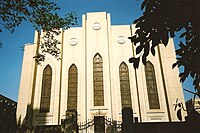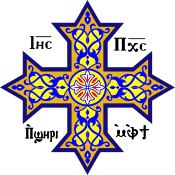
The Coptic Orthodox Church,, also known as the Coptic Orthodox Patriarchate of Alexandria, is an Oriental Orthodox Christian church based in Egypt. The head of the church and the See of Alexandria is the pope of Alexandria on the Holy Apostolic See of Saint Mark, who also carries the title of Father of fathers, Shepherd of shepherds, Ecumenical Judge and the 13th among the Apostles. The See of Alexandria is titular. The Coptic pope presides from Saint Mark's Coptic Orthodox Cathedral in the Abbassia District in Cairo. The church follows the Coptic Rite for its liturgy, prayer and devotional patrimony. Adherents of the Coptic Orthodox Church make up Egypt's largest and most significant minority population, and the largest population of Christians in the Middle East and North Africa (MENA). They make up the largest percentage of approximately 20 million Christians in Egypt

Pope Shenouda III was the 117th Pope of Alexandria and Patriarch of the See of St. Mark. His papacy lasted 40 years, 4 months, and 4 days, from 14 November 1971 until his death.

The Patriarch of Alexandria is the archbishop of Alexandria, Egypt. Historically, this office has included the designation "pope".
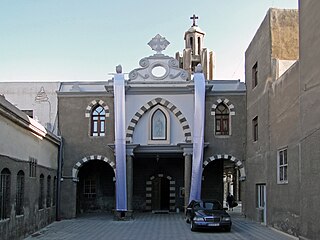
The Syriac Catholic Church is an Eastern Catholic Christian jurisdiction originating in the Levant that uses the West Syriac Rite liturgy and has many practices and rites in common with the Syriac Orthodox Church. Being one of the twenty-three Eastern Catholic Churches, the Syriac Catholic Church is a self-governed sui iuris particular church, while it is in full communion with the Holy See and with the entirety of the Roman Catholic Church.

The Catholic Church in Egypt is considerably small as compared to the rest of the Christian population in Egypt, which is a significant minority among Muslims. The Catholic population in Egypt is said to have begun during the British control of Egypt. However, many emigrated after the 1952 Revolution in Egypt, which also caused the overthrow and exile of King Farouk of Egypt. Catholics in Egypt belong to seven distinct ritual Particular Churches sui iuris, the largest being the Coptic Catholic Church, led by its Patriarch of Alexandria.
Cyril III, known as Cyril ibn Laqlaq, was the 75th Coptic Pope and Patriarch of Alexandria.
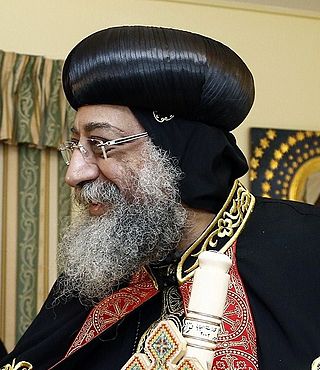
The pope, also known as the Bishop of Alexandria or the Coptic pope, is the leader of the Coptic Orthodox Church, with ancient Christian roots in Egypt. The primacy in the Coptic pope, similar to the Catholic belief in the Bishop of Rome as successor to Saint Peter, is rooted in his role as successor to Saint Mark. The current holder of this position is Pope Tawadros II, who was selected as the 118th pope on November 18, 2012.

Alphabetical list of Eastern Christianity-related articles on English Wikipedia

The Coptic Catholic Patriarchate of Alexandria is the Patriarchal and only Metropolitan see of the head of the Eastern sui iuris Coptic Catholic Church, a particular Church in the Catholic Church in full communion with the Holy See, which follows the Alexandrian Rite in its own Coptic language. He is thus the superior of all Coptic dioceses, mostly in and around Egypt, the word Copt(ic) being a corruption of the Greek word for Egypt(ian).

The Ethiopian Catholic Church or Ethiopian Eastern Catholic Church is a sui iuris (autonomous) Eastern Catholic church that is based in Ethiopia. As a particular church of the Catholic Church, it is in full communion with the Holy See. Established in 1930, the church is organised under a metropolitan bishop who exercises oversight of a number suffragan dioceses. In its liturgical services, it uses the Alexandrian Rite in the Ge'ez language.
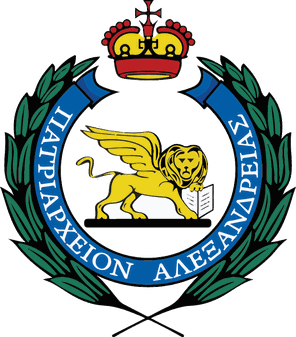
The Greek OrthodoxPatriarchate of Alexandria and all Africa, also known as the Greek Orthodox Church of Alexandria, is an autocephalous patriarchate that is part of the Eastern Orthodox Church. Its seat is in Alexandria and it has canonical responsibility for the entire African continent.
The Holy Synod of the Coptic Orthodox Church of Alexandria is the highest Orthodox authority in the Coptic Orthodox Church. It formulates the rules and regulations regarding matters of the Church's organisation and faith.

This article, dealing with the Coptic Orthodox Church in Africa, is about the Coptic Orthodox Church of Alexandria in African countries other than Egypt.

Coptic history is the part of the history of Egypt that begins with the introduction of Christianity in Egypt in the 1st century AD during the Roman period, and covers the history of the Copts to the present day. Many of the historic items related to Coptic Christianity are on display in many museums around the world and a large number is in the Coptic Museum in Coptic Cairo.

The Oriental Orthodox Churches are Eastern Christian churches adhering to Miaphysite Christology, with approximately 50 million members worldwide. The Oriental Orthodox Churches adhere to the Nicene Christian tradition. Oriental Orthodoxy is one of the oldest branches in Christianity.
Kyrillos Makarios also written as Cyrillus Macaire was a leader of the Coptic Catholic Church, an Eastern Catholic sui juris particular church of the Catholic Church. He served as Patriarch of Alexandria from 1899 to 1908 when he resigned.

The Armenian Catholic Eparchy of Alexandria (or Iskanderiya) is a suffragan eparchy (Eastern Catholicdiocese) of the Armenian Catholic Church sui iuris (Armenian Rite in Armenian language), in the Patriarch's own 'ecclesiastical province of Cilicia' (actually based in Beirut, Lebanon), covering Egypt and Sudan.

The Coptic Catholic Eparchy of Minya is a suffragan eparchy of the Coptic Catholic Church in its sole ecclesiastical province, that of the Coptic Catholic Patriarch of Alexandria.
The Coptic Catholic Eparchy of Giza is an Eastern Catholic diocese in Giza. It is one of the suffragan sees comprising the sole ecclesiastical province of the Coptic Catholic Patriarch of Alexandria, the head of the Coptic Catholic Church, a Particular church sui iuris.
